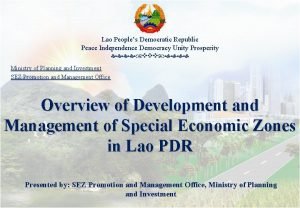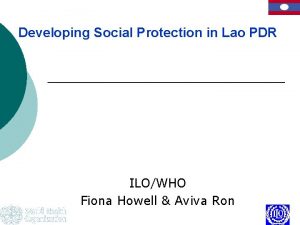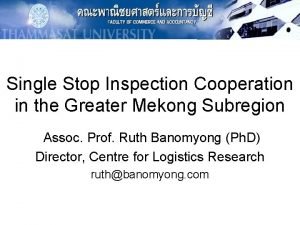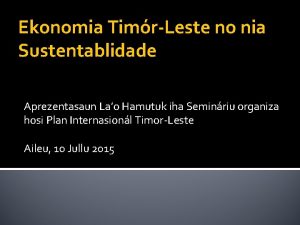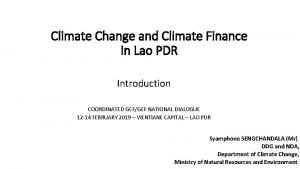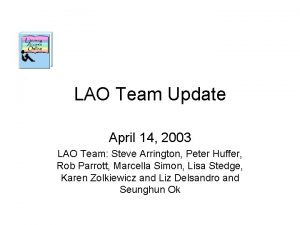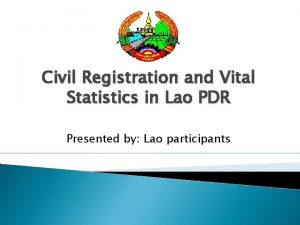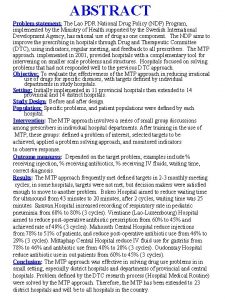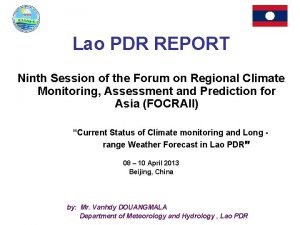Lao PDR Dr Mayphou MAHACHALEUN Deputy of Climate




















- Slides: 20

Lao PDR Dr. Mayphou MAHACHALEUN Deputy of Climate and Agro-meteorological Division Mobile phone: +856(20) 5566 2565 Email: mayphou@gmail. com, mayphou 66@yahoo. com RA II WIGOS Workshop 6 -8 November 2018, Beijing, China

Outline I. Introduction to the country and the NMHS II. Current status of DMH’s Facilities III. National requirements for observations IV. Summary

Introduction to the country and the NMHS Ø overview of the country: § The Lao People’s Democratic Republic (Lao PDR) is the only landlocked country in Southeast Asia. The capital is Vientiane (Lao: Viangchan), located on the Mekong River in the northern portion of the country. § The land area covers 236 800 km 2, of which more than 80 percent is mountainous. Ø Population: 6. 758 million (2016). Ø The Lao PDR is border stretches: Myanmar 235 km, Cambodia 541 km, the PR China 423 km, Thailand 1, 754 km, Vietnam 2, 130 km

Introduction to the country and the NMHS Ø Area: total: 236, 800 km² land: 230, 800 km² water: 6, 000 km² Ø Elevation extremes: lowest point: Mekong River 70 m highest point: Phou Bia 2, 817 m Ø List of mountains in Laos • Phou Bia, 2, 817 m • Phu Xai Leng, 2, 720 m • Rao Co, 2, 286 m • Phu Soi Dao, 2, 120 m • Phou Khe, 2, 079 m • Shiceng Dashan, 1, 830 m • Dong Ap Bia, 937 m

Introduction to the country and the NMHS Ø Climate characteristics in Lao PDR • Laos has the typical tropical monsoon (wet-dry) climate of the region, though the mountains provide some variations in temperature. During the rainy season (May to October), the winds of the southwest monsoon deposit an average rainfall of 1, 300 to 2, 300 mm, with totals reaching some 4, 100 mm on the Bolovens Plateau. The dry season November to April is dominated by the northeast monsoon. Minimum temperatures average between 16 and 21 °C in the cool months of December through February, increasing to highs of more than (32 °C) in March and April, just before the start of the rains. In the wet season the average temperature is (27 °C). Mar, Apr May, Jun, Jul, Aug, Sep, Oct Jan, Feb, Nov, Dec Indirect impact Direct impact

introduction to the NMHS The Department of Meteorology and Hydrology of Lao PDR (DMH) is a governmental department under Ministry of Natural Resources and Environment (MONRE), it is responsible for the collection and analysis of hydro-meteorological data and the provision of water supply conditions, weather forecasts, and issuing early warnings.

DMH’s Key Functional Services Governmental Department under Ministry of Natural Resources and Environment (MONRE) Provide Meteorological services Permanent Representative (PR) of Lao PDR to WMO Provide Hydrological Services Provide Seismological information & Services Issuing the Early Warning Develop Curriculum on Hydro-met (Training) For Protection, mitigation and reduction lost of life and properties of the people from the impacts from disastrous

DMH Structure Chart Ministry of Natural Resources and Environment (MONRE) Department of Meteorology and Hydrology Climate and Agro-met Div Hydrology Div Meteo-Network and Earthquake Div General affairs Div Provincial Hydro-met Station Staff Member Head Quarter : Total 74 prs , woman: 27 Volunteer : 3 prs , woman 1 Weather Forecasting Div Aeronautical Div Ph. D: , 2 Master: , 9 Bachelor: , 29 High Diploma , 13 : Technician 18 : In 17 Provinces 162 : prs. Woman 114 prs.

CURRENT STATUS OF DMH’S FACILITIES

DMH’s Vision • Professional in providing meteorological, hydrological, earthquake, environment and climate services in support of safety and sustainable development of the Lao community; • Highly competent in issuing hydro-met warning to reduce the loss of life and property during the severe weather occurred; and • Able to play an effective role in international and regional cooperation in the field of hydromet services.

DMH’s Vision • • Collect and exchange meteorological and hydrological data in accordance with WMO regulations for analysis, forecasting and warnings to the public on hazardous weather; Provide meteorological and hydrological data, information, forecasts and warnings to support activities of various sectors; Understanding of the country's weather, climate and hydrological situation; and further strengthen researches for the advancement of meteorological and hydrological sciences; Engage in international and regional cooperation in the fields of meteorology, including climatology, hydrology and seismology for the benefit of the nation;

National requirements for observations Meteorological Network: 51 stations Hydrology Network: 86 station Rain Gauge Network: 119 sites Aero-Meteorological Station Network § 10 Stations of the 51 stations are also services to aviation Since 2016, upgraded to AWS Projects: JICA: 18, WB: 16,

Hydrology Network: 86 station Manual Type Upgraded to AWL Projects: MRC: 12, JICA: 8, WB: 8, ADB: 9, China: 25

Seismic Station Network Station 1: Luang. Prabang China Latitude : Longitude: Elevation Vietnam Myanmar Lao P. D. R L a 19º 54’ N 102º 09’ E 305 m V i Station 2: Lak Sao e Latitude : Longitude: Elevation t Thailand 18º 12’ N 104º 59’ E 522 m o n P a D m R Cambodia Data Center: DMH Vientiane Latitude : Longitude: Elevation 17º 57’ N 102º 40’ E 171 m

Data management q Ø Data terminal (at the DMH) Data storage, Databases (Hyd. Met, MC-Excel, HYMOS vers 4. 50 ), • Ø Data quality checking Ø Analyzing and validation Ø Hydrologic yearbook Ø Data display

Hydro-Meteorological data collection system Internet WMO Centers’ Website, USGS, NOAA Dial-Up Via Modem Phone Line GTS Network R. A. II RTH Bang Kok 128 kbps FTP TCP / IP Provincial Services of Meteorology and Hydrology SSB Radio SMS DMH’s Telecommunication Center MTSAT; CMACAT, COMS! Satellite Doppler Weather RADAR Early Warning center Weather Forecast Division District Meteorological and Hydrological Stations Hydrological Division(Flood Forecasting Unit)

Forecast information & Early Warning Dissemination system Department of Meteorology & Hydrology LNMC Prime Minister’s Office http: //www. dmh. gov. la MAF Mo. NRE Aviation. Intl. Airport Local Authorities People in affecting areas WMO TC, NOAA GTS Network MRC Electricity Hydro– power MEM Line Ministry Concern Mass Media TV Radio News Paper Provincial Hydro – Meteo Stations Provincial TV Radio NDMC ( NDMO) Line ministries concerned PDMC Provincial Agriculture and Forestry Services DDMC Village Disaster Prevention Districts & villages affected areas

Summary of national observing capabilities DMH 2016 -2020 Priorities • Training and capacity building in support of the modernization actions and human resource renewal of DMH. • Continued modernization of the observing network for remaining river basins. • Improved models forecasting of serve weather and floods. • Strengthened capacity for longer term prediction of droughts and extreme weather related to climate change. • Continued operation of the observing and forecast services in support of the aviation, hydropower, and resource sectors.

Urgent needs Ø To fulfil its mandates and to respond the increasing national demands for services delivery as well as to cope with WMO strategic thrust and recommended framework, DMH Lao PDR has to rely on external resources , such as ODA from funding organizations, bilateral assistance from development partners and neighboring countries, to upgrade technical facilities : § Data Communication Link via satellite for sharing data and early warnings with other neighboring countries; § Assistance and Lesson learnt from internationalities on techniques and settingup National Early Warning Systems, including floods, drought, extreme weather and seasonal climate prediction and longer-term projection;

Thank you for your attention maypou@gmail. com
 Climate change 2014 mitigation of climate change
Climate change 2014 mitigation of climate change Yingjie lao
Yingjie lao Lao social security organization
Lao social security organization Lao card game
Lao card game Lao hamutuk
Lao hamutuk Peace independence democracy unity prosperity
Peace independence democracy unity prosperity Yingjie lao
Yingjie lao Fiona lao
Fiona lao Lao tzu water
Lao tzu water Lao national single window
Lao national single window Lao zhentang
Lao zhentang Lao gio
Lao gio ôi bởi con mà chúa mang thảm hình
ôi bởi con mà chúa mang thảm hình Lao hamutuk
Lao hamutuk Principles of tao
Principles of tao Stephen deputy md
Stephen deputy md Confused deputy
Confused deputy David elizalde
David elizalde Mark stowers
Mark stowers Deputy manager wikipedia
Deputy manager wikipedia Deputy medical director
Deputy medical director





